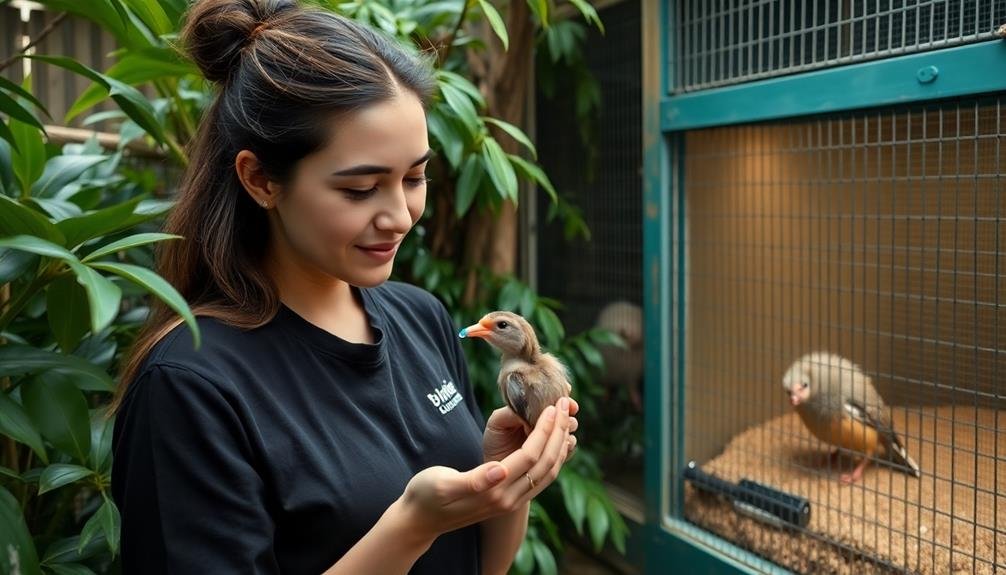Start your wildlife rehab journey with remote opportunities to ease into the experience. Choose low-stress animal interactions, focusing on calm species and observing from a distance. Opt for behind-the-scenes roles like food preparation or facility maintenance. Seek flexible scheduling options and communicate your needs clearly to staff. Partner with a buddy for support and focus on administrative tasks if direct animal contact is overwhelming. Attend virtual training sessions to build confidence and explore solitary outdoor activities like habitat restoration. Begin with short shifts to gradually adjust to the environment. These tips will help you find your comfort zone in wildlife rehabilitation volunteering.
Start With Remote Opportunities

For those who struggle with anxiety, starting your wildlife rehabilitation journey from the comfort of your own home can be an ideal first step. Many wildlife rehab centers offer remote volunteer opportunities that allow you to contribute without the stress of in-person interactions.
Look for organizations that need help with data entry, social media management, or fundraising efforts. These tasks can be done online and provide valuable support to wildlife rehab centers. You might also find opportunities to create educational materials or write grant proposals.
Another option is to become a virtual wildlife hotline operator. After training, you'll answer calls from the public about wildlife concerns, providing guidance and connecting callers with appropriate resources. This role lets you help animals and people while maintaining a comfortable distance.
Consider joining online forums or social media groups dedicated to wildlife rehabilitation. You can learn from experienced rehabbers, share knowledge, and offer support to others. This virtual engagement can help build your confidence and knowledge base before considering on-site opportunities.
Remote volunteering allows you to set your own pace and gradually increase your involvement as you feel more comfortable. It's an excellent way to contribute meaningfully while managing your anxiety.
Choose Low-Stress Animal Interactions
When selecting wildlife rehab opportunities, you'll want to focus on low-stress animal interactions.
You can start by choosing roles that let you observe animals from a distance or work with calm, non-threatening species.
These positions often require limited direct handling, which can help ease anxiety and build your comfort level gradually.
Observe From a Distance
At wildlife rehabilitation centers, you'll find opportunities to observe animals from a safe distance, minimizing stress for both you and the creatures. These centers often have designated viewing areas or observation decks where you can watch animals in their enclosures without direct interaction.
You might assist by monitoring behavior, tracking feeding patterns, or documenting recovery progress. Consider volunteering for tasks like maintaining surveillance cameras or updating informational displays about the animals. These roles allow you to contribute meaningfully while keeping a comfortable distance.
You could also help with data entry, updating medical records, or managing social media accounts to share success stories. Some centers offer "virtual volunteer" positions where you can contribute remotely.
This might involve researching wildlife rehabilitation techniques, creating educational materials, or managing donation drives online. If you're comfortable with public speaking, you could give virtual tours or presentations about the center's work.
Calm, Non-Threatening Species
While observing from a distance can be beneficial, you might feel ready to take a step closer to wildlife. When you're dealing with anxiety, it's essential to choose interactions with calm, non-threatening species. Many wildlife rehabilitation centers work with a variety of animals, so you can start with those that are less likely to trigger stress responses.
Consider volunteering with small mammals like rabbits or squirrels. These animals are often docile and require gentle care, making them ideal for anxiety-prone individuals.
Birds, particularly songbirds or doves, can also be soothing to work with due to their small size and generally calm demeanor.
Reptiles like turtles or tortoises offer another low-stress option. Their slow movements and quiet nature can be reassuring for those with anxiety. Some centers also care for non-venomous snakes, which can be surprisingly relaxing to handle once you're comfortable with them.
When selecting species to work with, communicate your concerns to the rehabilitation center staff. They can guide you towards animals that match your comfort level and gradually introduce you to more challenging species as your confidence grows.
Limited Direct Handling
Although you might be enthusiastic to interact with animals, it's vital to start with limited direct handling when managing anxiety. Focus on tasks that allow you to contribute without overwhelming your senses. Many wildlife rehab centers offer opportunities that don't require constant animal contact, allowing you to ease into the environment at your own pace.
Consider these low-stress animal interaction options:
- Preparing food and cleaning enclosures without animals present
- Assisting with administrative tasks, such as data entry or organizing supplies
- Observing and recording animal behaviors from a distance
These roles are significant for the center's operations and provide valuable support to the animals without putting you in high-pressure situations.
As you become more comfortable, you can gradually increase your level of animal interaction. Remember, it's okay to communicate your boundaries and preferences to the staff. They'll appreciate your honesty and work with you to find the best fit for your skills and comfort level.
Opt for Behind-the-Scenes Roles

If you're looking to contribute without direct animal contact, consider behind-the-scenes roles at wildlife rehabilitation centers.
You can provide valuable support through administrative tasks, facility maintenance, or food preparation duties.
These roles are essential for keeping operations running smoothly and can be less anxiety-inducing for those who prefer minimal interaction with animals or other volunteers.
Administrative Support Tasks
For those who prefer to avoid direct animal contact, administrative support roles offer an excellent way to contribute to wildlife rehabilitation. These behind-the-scenes tasks are essential for keeping the organization running smoothly and allow you to make a significant impact without triggering anxiety.
You can assist with data entry, helping to maintain accurate records of rescued animals, treatments, and outcomes. This information is critical for tracking progress and improving care protocols.
Another valuable role is managing volunteer schedules and coordinating shifts, ensuring the center is always adequately staffed.
Consider offering your skills in the following areas:
- Grant writing and fundraising research
- Social media management and content creation
- Website maintenance and updates
If you're comfortable with phone interactions, you might help with answering calls, scheduling appointments, or coordinating rescue pickups. These tasks free up time for hands-on caregivers to focus on animal rehabilitation.
Facility Maintenance Roles
Keeping a wildlife rehabilitation center in top shape requires more than just animal care. Facility maintenance roles offer excellent opportunities for volunteers with anxiety to contribute behind the scenes. You'll find these tasks less socially demanding while still making a significant impact.
Consider volunteering for cleaning duties. You can help sanitize animal enclosures, wash food bowls, or tidy up common areas. These tasks are often solitary and allow you to work at your own pace.
Landscaping and gardening roles are also anxiety-friendly options. You might mow lawns, tend to plants, or maintain outdoor habitats.
If you're handy, offer your skills for repair and maintenance work. Fix broken enclosures, patch fences, or perform basic plumbing or electrical tasks. These roles typically involve minimal interaction with others and allow you to focus on the job at hand.
Inventory management is another valuable behind-the-scenes role. Help organize supplies, restock shelves, or track equipment usage. You'll play an essential part in keeping the center running smoothly without the pressure of constant social interaction.
Food Preparation Duties
A significant but often overlooked aspect of wildlife rehabilitation is food preparation. If you're looking for a low-stress way to contribute, this behind-the-scenes role might be perfect for you.
You'll be responsible for preparing meals for various animals in the facility's care, ensuring they receive proper nutrition during their recovery.
Your duties may include:
- Measuring and mixing specialized diets for different species
- Chopping fruits and vegetables for herbivores
- Thawing and portioning frozen prey items for carnivores
You'll work in a quiet kitchen area, away from the hustle and bustle of animal care activities. This role allows you to focus on tasks without direct animal interaction, which can be ideal if you're anxious around wildlife.
You'll still play an essential part in their rehabilitation process, knowing that your efforts directly contribute to their health and recovery.
Food prep volunteers often work in small teams or independently, depending on the facility's needs. You'll follow strict hygiene protocols and recipes tailored to each animal's dietary requirements.
This role offers a structured environment with clear instructions, helping to reduce anxiety-inducing uncertainties. By volunteering in food preparation, you'll make a significant impact on wildlife rehabilitation while working in a calm, controlled setting.
Seek Flexible Scheduling Options
Flexibility's importance can't be overstated when seeking anxiety-friendly volunteer opportunities. When looking for wildlife rehab positions, prioritize organizations that offer flexible scheduling options. This approach allows you to manage your anxiety levels more effectively and maintain a healthy work-life balance.
Seek out rehab centers that offer various shift lengths, from short two-hour slots to full-day commitments. This range enables you to choose what works best for your comfort level and energy.
Some facilities may allow you to set your own hours or work on a drop-in basis, which can be ideal for days when your anxiety is more manageable.
Consider inquiring about remote volunteer opportunities, such as making educational materials or managing social media accounts. These tasks often come with flexible deadlines and can be completed from the comfort of your home.
Additionally, look for centers that offer on-call positions, where you're contacted only when extra help is needed. This arrangement gives you the freedom to decline if you're not feeling up to the task on a particular day.
Communicate Your Needs Clearly

When discussing volunteer opportunities, it's essential to express your comfort level boundaries clearly to the wildlife rehab staff.
You'll want to talk about any necessary accommodations before starting your role, ensuring everyone understands your needs.
Consider using written communication tools like email or forms to document your requirements, making it easier for staff to remember and implement them.
Express Comfort Level Boundaries
Communicating your comfort level and boundaries is essential when volunteering at a wildlife rehabilitation center. Be honest about your limitations and anxieties from the start. If certain animals or tasks make you uncomfortable, let the staff know. They'll appreciate your candor and can assign you tasks that align with your comfort zone.
Don't hesitate to speak up if you're feeling overwhelmed or need a break. Wildlife rehab can be fast-paced and emotionally challenging, so it's vital to recognize your limits. Remember, it's okay to say no to tasks that push you beyond your comfort level. Your mental health matters, and the center will benefit more from a volunteer who's comfortable and confident in their role.
Consider expressing your boundaries regarding:
- Physical contact with animals
- Handling specific species (e.g., snakes, bats)
- Participating in medical procedures
Discuss Accommodations Beforehand
Most wildlife rehabilitation centers are enthusiastic to accommodate volunteers with diverse needs and comfort levels. Before starting your volunteer work, it's essential to discuss your anxiety-related accommodations with the center's coordinator. Be clear about your triggers, limitations, and any specific support you might need.
Don't hesitate to ask for:
| Accommodation | Benefit | Example |
|---|---|---|
| Flexible schedules | Reduces pressure | Choose less busy hours |
| Quiet work areas | Minimizes overstimulation | Separate room for paperwork |
| Gradual task introduction | Builds confidence | Start with simple tasks |
Use Written Communication Tools
For volunteers with anxiety, written communication tools can be invaluable when interacting with wildlife rehabilitation center staff. These tools allow you to express your thoughts and needs clearly without the pressure of face-to-face conversations. Utilize email, text messages, or even handwritten notes to communicate with your supervisors and colleagues.
When using written communication, be specific about your concerns and requirements. Don't hesitate to ask questions or request clarification on tasks you're unsure about. This approach gives you time to process information and formulate your responses thoughtfully.
Consider creating a personal document outlining your strengths, limitations, and preferred working methods. Share this with your supervisor to help them understand how to best support you.
You can also use written tools to:
- Track your progress and accomplishments
- Request feedback on your performance
- Suggest improvements or ideas for the rehabilitation center
Begin With Short Volunteer Shifts
Wildlife rehabilitation centers' volunteer programs often offer short shifts for beginners, which can be ideal for those with anxiety. You'll find that starting with brief, manageable time commitments can help ease you into the volunteer experience. These shorter shifts allow you to familiarize yourself with the environment and tasks without feeling overwhelmed.
Consider starting with 2-3 hour shifts once or twice a week. This approach gives you time to adjust and build confidence gradually. As you become more comfortable, you can increase your involvement if desired. Many centers offer flexible scheduling options to accommodate various needs and preferences.
Here's a sample breakdown of common short shift options:
| Shift Type | Duration | Typical Tasks |
|---|---|---|
| Morning | 2 hours | Feeding, cleaning |
| Afternoon | 3 hours | Animal care, enrichment |
| Evening | 2 hours | Final feedings, bed prep |
| Weekend | 4 hours | Various responsibilities |
Partner With a Buddy

Teaming up with a volunteer buddy can greatly ease anxiety when working at a wildlife rehab center. This approach provides emotional support and helps you feel more confident in your role. When selecting a buddy, choose someone who understands your anxiety and is willing to work alongside you during shifts.
Discuss your concerns with your buddy beforehand, and establish a system for communicating during your volunteer work. You might agree on hand signals or code words to use if you need a break or feel overwhelmed. Having a trusted companion by your side can make unfamiliar tasks less intimidating and help you navigate challenging situations more comfortably.
A volunteer buddy can offer:
- Reassurance when dealing with new or frightening animals
- Assistance in remembering protocols and procedures
- A calming presence during stressful moments
As you gain experience and confidence, you may find that you need less support from your buddy. However, maintaining this partnership can continue to enhance your volunteering experience and provide a sense of camaraderie.
Focus on Administrative Tasks
Flexibility in volunteer roles can be a game-changer for those with anxiety. If you're not comfortable with hands-on animal care, consider focusing on administrative tasks at wildlife rehabilitation centers. These behind-the-scenes roles are essential for keeping operations running smoothly and can be less stressful for anxiety-prone volunteers.
You might help with data entry, updating animal records, or managing inventory. These tasks often allow for a quieter work environment and more predictable routines.
You could also assist with scheduling, answering phones, or responding to emails, which can be done remotely in some cases.
If you're creative, you might contribute by designing educational materials, updating the center's website, or managing social media accounts. These roles let you support wildlife rehabilitation efforts without direct animal contact.
Don't underestimate the impact of administrative work. By handling these tasks, you're freeing up time for other volunteers to focus on animal care.
You're also developing valuable skills that can boost your confidence and potentially lead to new career opportunities.
Attend Virtual Training Sessions

Knowledge is power, especially when it comes to wildlife rehabilitation. By attending virtual training sessions, you can gain valuable insights and skills without the pressure of in-person interactions.
These online courses offer a comfortable way to learn about animal care, rehabilitation techniques, and safety protocols from the comfort of your own home.
Many wildlife rehabilitation centers now provide virtual training options, allowing you to:
- Learn at your own pace
- Pause and replay sessions as needed
- Interact with instructors through chat features
Virtual training sessions often cover a wide range of topics, including species identification, basic medical care, and proper handling techniques.
You'll also learn about the legal aspects of wildlife rehabilitation and the importance of proper documentation.
As you progress through these online courses, you'll build confidence in your abilities and feel more prepared to take on hands-on volunteer roles when you're ready.
Some organizations even offer certificates upon completion, which can be a great addition to your resume or volunteer portfolio.
Explore Solitary Outdoor Activities
Nature enthusiasts with anxiety can find solace in solitary outdoor activities that support wildlife rehabilitation efforts. These tasks allow you to contribute without the pressure of social interactions. You'll enjoy the therapeutic benefits of nature while making a difference.
Consider these anxiety-friendly outdoor volunteer activities:
| Activity | Description | Benefits |
|---|---|---|
| Wildlife surveys | Count and record animal populations | Contributes to conservation data |
| Habitat restoration | Plant native species or remove invasive ones | Improves ecosystems for wildlife |
| Litter cleanup | Remove trash from natural areas | Prevents animal injuries and ingestion |
| Trail maintenance | Clear paths and repair signage | Guarantees safe access for rescuers |
| Nest box monitoring | Check and maintain artificial nesting sites | Supports breeding populations |
Start by contacting local wildlife rehabilitation centers or conservation organizations to inquire about these opportunities. They'll often provide necessary training and equipment. Remember to work at your own pace and take breaks when needed. You can also create a flexible schedule that suits your comfort level. By engaging in these solitary activities, you're not only helping wildlife but also managing your anxiety through mindful outdoor experiences.
Frequently Asked Questions
How Do I Handle Unexpected Animal Emergencies as an Anxious Volunteer?
You'll handle unexpected animal emergencies by staying calm and following protocols. Take deep breaths, focus on the task at hand, and don't hesitate to ask for help. Remember your training and trust your instincts. You've got this!
Are There Specific Wildlife Species Better Suited for Anxiety-Prone Volunteers?
You'll find that smaller, calmer animals like rabbits, songbirds, or turtles are often better suited for anxiety-prone volunteers. These species typically require less intense handling and have slower-paced care routines, which can help ease your anxiety.
What Mental Health Resources Are Available for Wildlife Rehab Volunteers?
You'll find various mental health resources for wildlife rehab volunteers. Many organizations offer counseling services, support groups, and stress management workshops. You can also access online forums, self-care guides, and mindfulness apps specifically designed for animal caregivers.
How Can I Manage Anxiety Triggers Like Loud Noises in a Rehab Setting?
You can manage loud noises in a rehab setting by wearing noise-canceling headphones or earplugs. Try deep breathing exercises, taking breaks in quiet areas, and gradually exposing yourself to louder environments. Don't hesitate to communicate your needs to supervisors.
Is It Possible to Volunteer if I Have Animal-Related Phobias?
You can still volunteer with animal phobias. Start by discussing your fears with the rehab center. They'll help you find roles that don't trigger your phobias. Gradually, you might overcome fears through controlled exposure and education.
In Summary
You've got this! By following these tips, you'll find anxiety-friendly ways to contribute to wildlife rehabilitation. Remember, there's no shame in starting small or needing accommodations. Your efforts, no matter how modest, make a real difference. Don't hesitate to reach out to rehab centers and explain your situation. They'll appreciate your honesty and desire to help. With patience and self-compassion, you'll discover rewarding volunteer opportunities that suit your needs and support wildlife conservation.





Leave a Reply